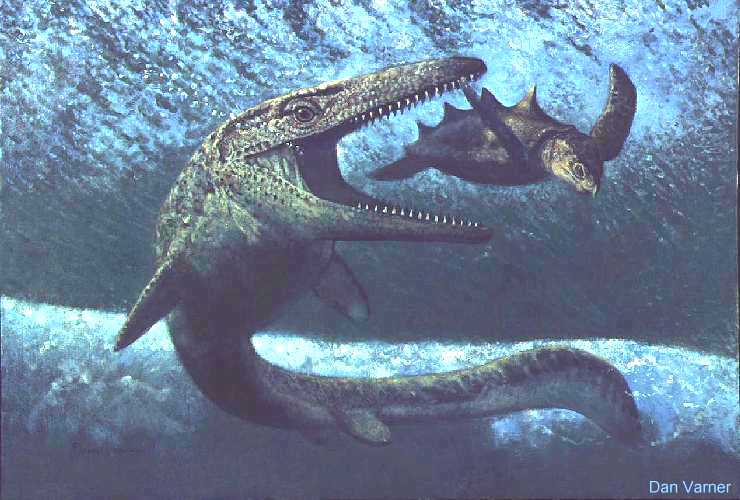
A Field Guide to Fossils of the Smoky Hill Chalk
Part 3:
Marine Reptiles
Copyright © 2000-2011 by Mike Everhart
Updated 01/25/2011
LEFT: Clidastes and Calcarichelys (a marine turtle) Copyright © Dan Varner; used with permission of Dan Varner.
 |
A Field Guide to Fossils of the Smoky Hill ChalkPart 3:Marine Reptiles
Copyright © 2000-2011 by Mike EverhartUpdated 01/25/2011
LEFT: Clidastes and Calcarichelys (a marine turtle) Copyright © Dan Varner; used with permission of Dan Varner. |
MARINE REPTILES - Several varieties of reptiles were well adapted for living and competing successfully in mid-ocean during the Late Cretaceous. It is likely that some, including mosasaurs, plesiosaurs and pterosaurs, were as highly evolved for survival at sea and in the air as the dinosaurs were on land. All marine reptiles were air breathers, and had to surface periodically in a manner similar to modern whales and porpoises.
Turtles - There were two major groups of marine turtles that lived in the Western Interior Sea. These turtles probably ate seaweed and jellyfish and must have migrated to the east or west to find sandy shorelines where they could lay their eggs. Turtle bone is dense and very finely grained.
For more information on turtles, take a look at Dr. Elena G. Kordikova's excellent Chelonia Website from Stuttgart, Germany.
Toxochelyids - Toxochelys latiremis is the most common species of turtle found in the Smoky Hill Chalk.
Protostegids - Protostega and Archelon were giant (Volkswagen-sized!) sea turtles that are found in Cretaceous deposits.
| BELOW: Left: Pam Everhart works on the partial remains of a Protostega gigas that she discovered in July, 1994 in Logan County, Kansas. Center - Most of the right half of the turtle's lower plastron is exposed here. Right: Removed from the chalk, the 'spikey' look of the the ;lower shell is very apparent. We donated this specimen to the Sternberg Museum in 1997 where it is curated as FHSM VP-13448 (Our EPC 1994-42; about 30 inches in maximum length). |
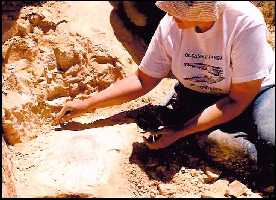 |
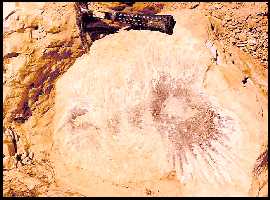 |
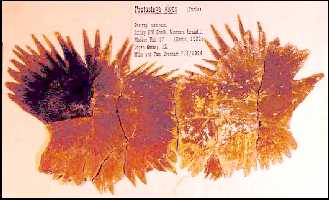 |
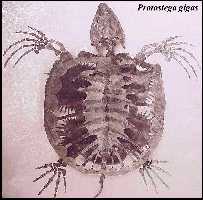 |
LEFT: A photo by Charles H. Sternberg of a mounted specimen of Protostega
gigas from the chalk of western Kansas. The specimen is now in the Carnegie Museum of Natural
History in Pittsburg, PA. A more recent picture is HERE.
This is a composite specimen (#1420 and 1421), both discovered by Sternberg about
"three miles northwest of Monument Rock" and acquired by the Carnegie in
1904. See also: Sternberg, C. H. 1899. The first great roof. Popular Science News 33:126-127, 1 fig. |
The following information was provided by Dr. Kraig Derstler of the University of New Orleans. Kraig is one of the few people currently studying protostegid turtles.
"Very little is written about Protostegids, other than the descriptive stuff by Wieland and his colleagues in the 1890's and earliest 1900's. Protostega is a huge-headed sea turtle. The species are pretty poorly defined at present. Specimens come from the Niobrara of Kansas, the Pierre of Kansas, Colorado, Wyoming, and South Dakota, the Mooreville, Demopolis, and Eutaw formations of Alabama and Mississippi, and the Campanian - Santonian marls of Texas. Possible scraps also come from other Santonian-lowermost Maastrichtian deposits around the world. Other Protostegids (Calcarichelys, Chelosphargis, and a couple of unnamed things) range from the Albian through the latest Maastrichtian worldwide.
Archelon ischyros has a normal-sized skull, proportionally much smaller than Protostega. However, it has that distinctive hooked snout. It is so far confirmed only from the upper half Pierre in South Dakota. (Reports from Colorado and elsewhere are pretty unbelievable.)
Concerning size, the largest Protostega is a 3.4m beast in the Dallas Museum of Natural History. I was consultant for this exhibit and I'm pretty confident of the identification as well as the size. The Yale Archelon is 3.0-3.1m, but another I've studied is 4.6m long! It is virtually perfect and articulated. As a result, the size and the identification are both solid.
I've never seen any Niobrara Protostega material from an animal that was more than about 2-2.5m long. Niobrara giants may have existed, but I haven't seen any evidence. And, I've never seen any signs of Archelon in the Niobrara. However, there are lots of small to medium-size Chelosphargis specimens and possibly some pieces of the "thorny Protostegid" Calcarichelys". ( Dr. Kraig Derstler )
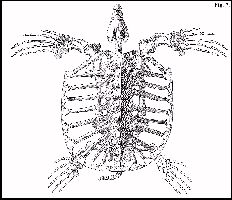 |
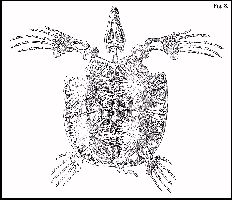 |
Drawings of Archelon ischyros, adapted from
Wieland, 1909. (CLICK TO ENLARGE) FAR LEFT: Dorsal view LEFT: Ventral view RIGHT: Ventral view, plastron removed. |
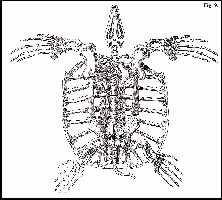 |
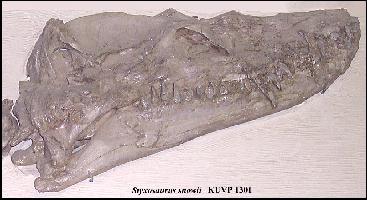 |
Plesiosaurs- There were at least three major varieties of plesiosaurs in the Western Interior Sea during the Cretaceous. The short-necked pliosaurs, short-necked polycotylids, or long necked elasmosaurs were never common, however, and plesiosaur remains are rare in the Smoky Hill Chalk. Most finds of plesiosaur material consist of pieces of paddles or a series of vertebrae that were the remains of shark attacks on dead or dying plesiosaurs. It is likely that plesiosaurs gave birth to their young at sea and may have lived in family pods similar to dolphins and whales. Plesiosaur bone is dense, with a fine grain, and the vertebrae are concave on both sides. The remains of elasmosaurs (Elasmosaurus and Styxosaurus) and polycotylids (Dolichorhynchops) remains become much more common above the chalk in the Pierre Shale formation. |
 |
Polycotylids (Short Necked Plesiosaurs)
- Short necked plesiosaurs like Polycotylus and Dolichorhynchops are
found occasionally in the upper chalk. These animals were apparently strong, fast swimmers
and fed on fish. New evidence indicates that polycotylids were
also present in the lower chalk. LEFT:The skeleton of Dolichorhynchops osborni (lateral view, about 10 feet - Adapted from Buchanan, 1984) |
| Elasmosaurids (Long-necked
plesiosaurs) - These plesiosaurs probably lived in the inland sea in small numbers but
little data exists on their occurrence. It's possible that they avoided the deeper
water in the center of the seaway, preferring to remain closer to shore. Elasmosaurus
apparently swam slowly and used it's long neck to catch small fish from below. RIGHT: The skeleton of Styxosaurus snowii (Lateral view, 30-45 feet - Adapted from Buchanan, 1984) |
 |
Long necked plesiosaurs swallowed smooth stones (gastroliths or gizzard stones) that were used to help grind up their food. Read the story of Elasmosaurus platyurus here.
Mosasaurs - Last of the great marine reptiles.
 |
The relative abundance of small, immature mosasaurs living in a
hostile mid-ocean environment, hundreds of miles from land or sheltered areas seems to
indicate that mosasaurs lived in groups and protected their young. Mosasaurs fed on all
types of prey, including ammonites, squid, fish, plesiosaurs, turtles, birds, pteranodons
and other mosasaurs. A number of genera are present in the chalk but Tylosaurus, Platecarpus
and Clidastes were the most common. Mosasaur bone is denser than fish bone, but
not as dense as plesiosaur or turtle bone, and has a distinct surface texture. Mosasaur
vertebrae are concave on the anterior end and convex on the posterior end. The remains of cartilage, particularly from the rib cage and the tympanic membrane covering the ear, are fairly commonly fossilized in mosasaur specimens. Imprints of the scales covering the skin have been found in several sets of remains. Although mosasaurs had large paddles, it is more likely that they used their strong, sinuous tails to propel themselves rapidly through the water. Recent (1995, 1997 and 1998) evidence has shown that even large Tylosaurs were attacked or scavenged by Cretoxyrhina sharks.
LEFT: Dorsal, lateral and ventral views of the skull of Clidastes sp. (about 18 inches).
|
Tylosaurus - Tylosaurs were the largest of the mosasaurs in the chalk, reaching forty feet or more feet in length. The earliest species, Tylosaurus nepaeolicus, occurs in the lower 1/3 of the Smoky Hill chalk while Tylosaurus proriger, the largest of the Tylosaurs, is found in the middle and upper chalk. A third, as yet undescribed species appears to be intermediate between the other two and may be the most common species found in the lower 1/3 of the chalk.
Platecarpus - This genus is represented by medium sized animals that are found throughout the chalk. Russell (1967) counted specimens of mosasaurs in various museum collections and found that Platecarpus was the most commonly represented. Currently two species are known: Platecarpus tympaniticus and P. planifrons.
Clidastes - This genera is the smallest of the three types of mosasaurs found commonly in the chalk. Until recently, it was documented only in the upper chalk. A new specimen found in 1995 in the low chalk may indicate that Clidastes liodontus occurred there in small numbers. Clidastes may have been the most primitive of all the mosasaurs living in the Western Interior Sea (about 12-15 feet). Mosasaur remains found in the Fairport Chalk (Turonian) of Kansas are the earliest mosasaurs found anywhere, and are probably closely related to Clidastes. (See Martin and Stewart, 1977)
 |
The skeleton of Clidastes propython (lateral view, about 12 feet) |
Continued on next page.................................
A Field Guide to Fossils of the Smoky Hill Chalk - Part 4; Pteranodons and Birds